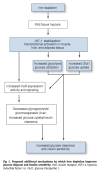We had blood drawn yesterday for a second iron panel and my results are encouraging.
Now, keep in mind that I started out with Ferritin of 367. At the time I didn't do the other parts of the iron load test, I just decided that 367 wasn't acceptable. So, I set about aggressively reducing it. I had 800 ccs of blood removed over a period of about 10 days: 2 X 550 and 1 X 250. Additionally, in the past three weeks I've done 3 cycles of EDTA one of which included DMSA.
So, yesterday's numbers are:
Hemoglobin: 11.8 (11.5-16)
Hematocrit: 37 (30-47)
Ferritin: 239.3 (10-291)
Serum Iron: 48 (50-170)
Iron Binding capacity: 335 (295-385)
Transferrin: 2.39 (2.50-3.80)
Transferrin saturation: 14%
That means my Ferritin dropped 128 units in that three week period.
If you lose about 30 for every 550 ccs of blood, that would account for 75 units drop which means that the EDTA must have pulled out 53 - which is significant compared to the 75 from phlebotomy OR some of the drop was due to some other cause.
So, I'm going to do two additional rounds of EDTA without another phlebotomy and then get another test and see what happens. I'm really curious about that possible route for unloading.
Now, keep in mind that I started out with Ferritin of 367. At the time I didn't do the other parts of the iron load test, I just decided that 367 wasn't acceptable. So, I set about aggressively reducing it. I had 800 ccs of blood removed over a period of about 10 days: 2 X 550 and 1 X 250. Additionally, in the past three weeks I've done 3 cycles of EDTA one of which included DMSA.
So, yesterday's numbers are:
Hemoglobin: 11.8 (11.5-16)
Hematocrit: 37 (30-47)
Ferritin: 239.3 (10-291)
Serum Iron: 48 (50-170)
Iron Binding capacity: 335 (295-385)
Transferrin: 2.39 (2.50-3.80)
Transferrin saturation: 14%
That means my Ferritin dropped 128 units in that three week period.
If you lose about 30 for every 550 ccs of blood, that would account for 75 units drop which means that the EDTA must have pulled out 53 - which is significant compared to the 75 from phlebotomy OR some of the drop was due to some other cause.
So, I'm going to do two additional rounds of EDTA without another phlebotomy and then get another test and see what happens. I'm really curious about that possible route for unloading.

